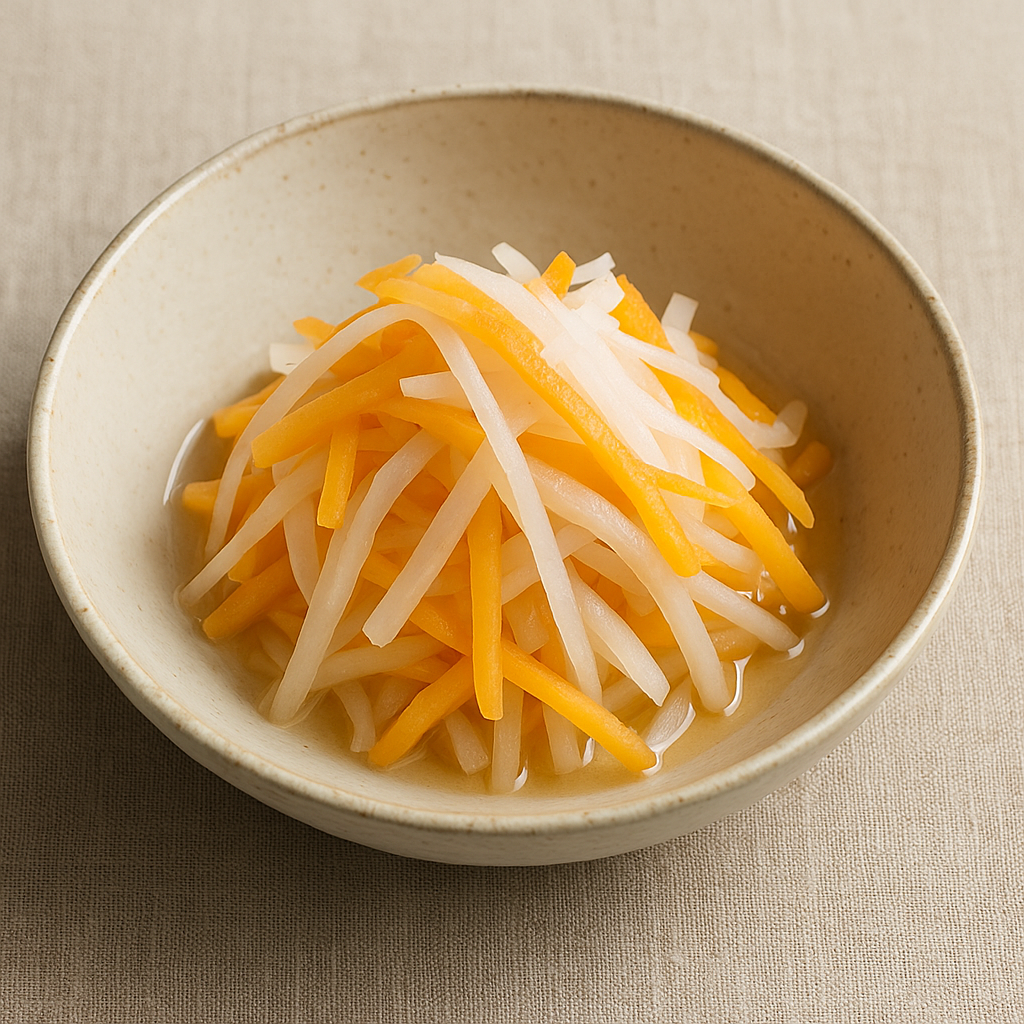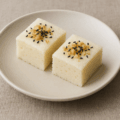柿なます(宮城)の特徴
甘い柿と大根のコントラストが爽やかです
宮城では、冬に出回る甘い柿と大根を合わせた「柿なます」が箸休めとして親しまれます。柿の自然な甘みと大根のさっぱり感、米酢のきれが合わさり、油の多い主菜の脇で口をサッパリさせてくれます。
ゆず香るやさしい三杯酢仕立て
米酢・砂糖・塩の基本に、少量のだしや昆布を合わせると角が取れてまろやかになります。仕上げにゆず皮を少量添えると香りが立ち、冬らしい風味にまとまります。
柿なます(宮城) レシピ
材料
- 柿(甘柿・固め) … 1個(200g目安)
- 大根 … 200g
- 塩(大根の下処理用) … 小さじ1/3
- 米酢 … 大さじ2.5
- 砂糖 … 大さじ1
- 塩 … ひとつまみ
- だし(昆布出汁・水でも可) … 大さじ1
- ゆず皮(せん切り) … 少々
- (お好みで)塩昆布 … 少々
- (お好みで)白いりごま … 小さじ1
作り方
- 大根は皮をむき、細いせん切りにする。塩(下処理用)をまぶして5〜10分おき、水気をしっかり絞る。
- 柿は皮と種を除き、細いせん切りにする(幅を大根にそろえる)。
- ボウルに米酢・砂糖・塩・だしを合わせ、砂糖が溶けるまで混ぜる。
- 大根・柿を加えて和え、冷蔵で10〜15分なじませる。
- 器に盛り、ゆず皮をのせる。好みで塩昆布や白ごまを散らす。
シェフのワンポイントアドバイス
- 柿はやや固めを選ぶと、水っぽくならず食感がきれいに出ます。
- 大根は下塩でしっかり水分を抜くと、味がぼけずに仕上がります。
- 甘さは柿の熟度で変わります。砂糖は加減し、最後にひとつまみの塩で味を締めます。
- ゆず皮は少量で十分です。入れすぎると香りが勝ちやすいので控えめにします。
栄養価(1人分の目安)
- エネルギー … 約110kcal
- たんぱく質 … 約1g
- 脂質 … 約0.2g
- 炭水化物 … 約26g
- 食塩相当量 … 約1.2g
- 特徴成分 … カリウム・βカロテン・食物繊維を含みます
歴史
冬の箸休めとして受け継がれてきました
柿の出回る季節に合わせ、宮城や東北各地で大根のなますに柿を合わせる食文化が根づいています。さっぱりとした副菜として家庭の食卓で親しまれてきました。かつては渋柿で長期熟成させる事で甘味を出していましたが、現在は甘柿を使って手軽に作ります。
正月料理や祝い膳にも登場します
紅白の色合いが晴れやかで、酢のきいた味わいはごちそうの合間の口直しに適しています。家庭ごとに配合や具材の工夫が受け継がれています。
昆布やゆずで地域らしさを添えて
三陸沿岸では昆布のうま味やゆずの香りを添えることが多く、素材を生かしたやさしい味に仕上げます。塩昆布や白ごまを加える変化も楽しまれています。
English Version
Features of Kaki Namasu (Miyagi)
Refreshing contrast of sweet persimmon and crisp daikon
In Miyagi, “kaki namasu” pairs winter sweet persimmons with daikon for a bright palate cleanser. The natural sweetness of persimmon meets daikon’s clean snap and the clarity of rice vinegar—ideal alongside richer mains.
Gentle sanbai-zu with a hint of yuzu
A basic sanbai-zu (rice vinegar, sugar, salt) rounded with a touch of kombu-dashi gives mild acidity and umami. A small flourish of yuzu zest brings a seasonal aroma and neat finish.
Recipe – Kaki Namasu (Miyagi)
Ingredients (Serves 2–3 as a side)
- Sweet persimmon (firm) … 1 (about 200 g)
- Daikon … 200 g
- Salt (for draining daikon) … 1/3 tsp
- Rice vinegar … 2.5 Tbsp
- Sugar … 1 Tbsp
- Salt … a pinch
- Kombu dashi (or water) … 1 Tbsp
- Yuzu zest, julienned … a little
- (Optional) Shio-kombu … a little
- (Optional) Toasted white sesame … 1 tsp
Directions
- Peel and julienne the daikon. Toss with 1/3 tsp salt; rest 5–10 minutes, then squeeze out moisture thoroughly.
- Peel and seed the persimmon; julienne to match the daikon’s width.
- In a bowl, mix rice vinegar, sugar, a pinch of salt, and kombu dashi until the sugar dissolves.
- Add daikon and persimmon; toss to coat and chill 10–15 minutes to meld.
- Plate and top with yuzu zest. Add shio-kombu or sesame if desired.
Chef’s Tips
- Choose a slightly firm persimmon so the salad stays crisp, not watery.
- Proper salting and draining of daikon prevents diluted flavor.
- Sweetness varies with ripeness—adjust sugar and finish with a small pinch of salt to tighten the taste.
- Use yuzu zest sparingly; a little goes a long way.
Nutrition (per serving, approx.)
- Energy … ~110 kcal
- Protein … ~1 g
- Fat … ~0.2 g
- Carbohydrates … ~26 g
- Salt equivalent … ~1.2 g
- Notable nutrients … potassium, β-carotene, dietary fiber
History
A winter palate cleanser in Miyagi and across Tōhoku
Aligning with persimmon season, adding fruit to daikon namasu became a household staple—light, refreshing, and balanced.
From astringent fruit to modern sweet varieties
In the past, astringent persimmons were ripened to draw out sweetness; today, sweet varieties make the dish quicker and easier to prepare.
Regional touches of kombu and yuzu
Along the Sanriku coast, gentle kombu umami and yuzu aroma are common additions. Shio-kombu or toasted sesame offer pleasant variations.



何でも質問してください!